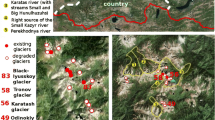Abstract
The post to late glacial valley reconstruction is focused on the Mani- Baska and Phuparash valleys on the Rakaposhi- Haramosh Muztagh in the south Karakoram. The recently glaciated valleys join the Indus valley near Sassi at 1500 m. The knowledge of the tributary valley reconstruction can be seen in the context of the scientific discussion about the extent of glaciation along the main Indus valley. Today, the recent avalanche fed glaciers come down from high lying catchment areas with an average altitude of 6700–6800 m and terminate at 2700 m. Snow line runs at 4700–4800 m in the steep flanks which is common in the Karakoram Mountains. The postglacial extent is marked by the great lateral moraine (GLM) and reached down not more than 2.5–5 km away from the recent glaciers with a calculated snow line depression of 300 m in maximum. It can be shown that the valleys were already glaciated during the lastest Late Glacial down to the valley outlet at 1500 m. The snow line was depressed 600–700 m during that period. A high glacial ice filling of the Haramosh valley and glacial erosion of the flat top of the Darchan ridge as an intermediate valley head is strongly probable.
Similar content being viewed by others
References
Dainelli, G. (1922): Studi sul Glaciale. Risultati Geologici e Geografici, Relazioni scientifiche della Spedizione Italiana De Fillipi nell’ Himalaya, Caracorum e Turchestan Cinese (1913–1914). Vol. III, Ser. II.
Haserodt, K. (1989): Zur pleistozänen und postglazialen Vergletscherung zwischen Hindukusch, Karakorum und Westhimalaya.– Beiträge und Materialien zur Regionalen Geographie, 2: 182–233.
Iturrizaga, L. (1999): Typical debris accumulation forms and formations in High Asia.A glacial history-based concept of the origin of the Postglacial debris accumulation landscapes in subtropical high mountains with selected case examples from the Hindu Kush, the Karakoram and the Himalayas.– GeoJournal, 47(1/2, Tibet and High Asia (V), Ed: Kuhle, M.): 277–339.
Kick, W. (1985): Geomorphologie und rezente Gletscheränderungen in Hochasien.– Regensburger Geographische Schriften, 19/20: 53–77.
König, O. (2001): Investigations on the Quaternary Glaciation in the Khumbu Himal (Nepal, East-Himalaya).– GeoJournal, (Tibet and High Asia VI, Glacio-geomorphology and prehistoric Glaciation in the Karakoram and Himalaya, Ed: Kuhle, M.): 345–363.
Kuhle, M. (1988a): The Pleistocene Glaciation of Tibet and the Onset of Ice Ages-An Autocycle Hypothesis.– GeoJournal, 17 (4, Tibet and High-Asia. Results of the Sino-German Joint Expeditions (I), Eds: Kuhle, M.; Wang Wenjing): 581–596.
Kuhle, M. (1988b): Topography as a Fundamental Element of Glacial Systems. A New Approach to ELA-Calculation and Typological Classification of Paleo-and Recent Glaciation.– GeoJournal, 17 (4, Tibet and High-Asia, Results of the Sino-German Joint Expeditions (I), Eds: Kuhle, M.; Wang Wenjing): 545–568.
Kuhle, M. (1989): Die Inlandvereisung Tibets als Basis einer in der Globalstrahlungsgeometrie fuâenden, reliefspezifischen Eiszeittheorie.– Petermanns Geographische Mitteilungen, 133(4): 265–285.
Kuhle, M. (1991a): Glazialgeomorphologie. Wissenschaftliche Buchgesellschaft, Darmstadt. 213S.
Kuhle, M. (1991b): Die Vergletscherung Tibets und ihre Bedeutung für die Geschichte des nordhemisphärischen Inlandeises.– Sitzungsberichte der Akademie der Wissenschaften und der Literatur Mainz, Paläoklimaforschung, 1 (Klimageschichtliche Probleme der letzten 130 000 Jahre, Ed: Frenzel, B.): 293–306.
Kuhle, M. (1993): The Pleistocene Glaciation of the Himalaya and Tibet and its Impact on the Global Climate: A Relief-specific Ice Age Theory.– Journal of the Nepal Research Center (JNRC), 9: 101–140.
Kuhle, M. (1994): Present and Pleistocene Glaciation on the North-Western Margin of Tibet between the Karakorum Main Ridge and the Tarim Basin Supporting the Evidence of a Pleistocene Inland Glaciation in Tibet.– GeoJournal, 33 (2/3, Tibet and High Asia, Results of the Sino-German and Russian-German Joint Expeditions (III), Ed: Kuhle, M.): 133–272.
Kuhle, M. (1997): New Findings concerning the Ice Age (Last Glacial Maximum) Glacier Cover of the East-Pamir, of the Nanga Parbat up to the Central Himalaya and of Tibet, as well as the Age of the Tibetan Inland Ice.– GeoJournal, 42 (2–3, Tibet and High Asia. Results of Investigations into High Mountain Geomorphology, Paleo-Glaciology and Climatology of the Pleistocene (Ice Age Research) IV, Ed: Kuhle, M.): 87–257.
Kuhle, M. (1998): Reconstruction of the 2.4 Million qkm Late Pleistocene Ice Sheet on the Tibetan Plateau and its Impact on the Global Climate.– Quaternary International, 45/46: 71–108 (Erratum: Vol. 47/48:173–182 (1998) included).
Kuhle, M. (2001): The maximum Ice Age (LGM) glaciation of the Centraland South Karakorum: an investigation of the heights of its glacier levels and ice thicknesses as well as lowest prehistoric ice margin positions in the Hindukush, Himalaya and in East-Tibet on the Minya Konkamassif.– GeoJournal, (Tibet and High Asia VI, Glacio-geomorphology and prehistoric Glaciation in the Karakoram and Himalaya, Ed: Kuhle, M.): 3–290.
Loewe, F. (1924): Die Eiszeit in Kaschmir, Baltistan und Ladakh.– Zeitschrift der Gesellschaft für Erdkunde,: 42–53.
Meiners, S. (1996): Zur Rezenten, Historischen und Postglazialen Vergletscherung an ausgewählten Beispielen des Tien Shan und des Nord-West-Karakorum.– GeoAktuell, 2: 1–200.
Meiners, S. (1997): Historical to Postglacial glaciation and their differentiation from the Late Glacial period on examples of the Tian Shan and the N.W. Karakorum.– GeoJournal, 42 (2–3, Tibet and High Asia, Results of Investigations into High Mountain Geomorphology, Paleo-Glaciology and Climatology of the Pleistocene (Ice Age Research IV), Ed: Kuhle, M.): 259–302.
Meiners, S. (1998a): Beobachtungen zur jüngeren Vergletscherungsgeschichte im Nordwestkarakorum und zentralen Tienschan.– Petermanns Geographische Mitteilungen, 142(3/4): 227–232.
Meiners, S. (1998b): Preliminary Results concerning Historical to Post-Glacial Glacier stages in the N.-W.-Karakorum (Hispar Muztagh, Batura Muztagh, Rakaposhi Range).– Scientific studies, 4/I (Pakistan German Research Project, Culture Area Karakorum, Karakorum-Hindukush-Himalaya: Dynamics of change): 49–69.
Orographical Sketch Map Karakoram Sheet 1. (1990). publ. Swiss Foundation for Alpine Research Zurich, Switzerland.
Roethlisberger, F. (1986): 10000 Jahre Gletschergeschichte der Erde. Verlag Sauerländer, Aarau, Frankfurt am Main, Salzburg.
Wiche, K. (1960): Klimamorphologische Untersuchungen in Westlichen Karakorum.– In: Tagungsbericht und wissenschaftliche Abhandlungen des Deutschen Geographentag Berlin. Vol. 32. S. 190–203; Wiesbaden.
Author information
Authors and Affiliations
Rights and permissions
About this article
Cite this article
Meiners, S. The post to late glacial valley reconstruction on the Haramosh north side (Mani, Baska and Phuparash valleys). GeoJournal 54, 429–450 (2001). https://doi.org/10.1023/A:1021325801035
Issue Date:
DOI: https://doi.org/10.1023/A:1021325801035




